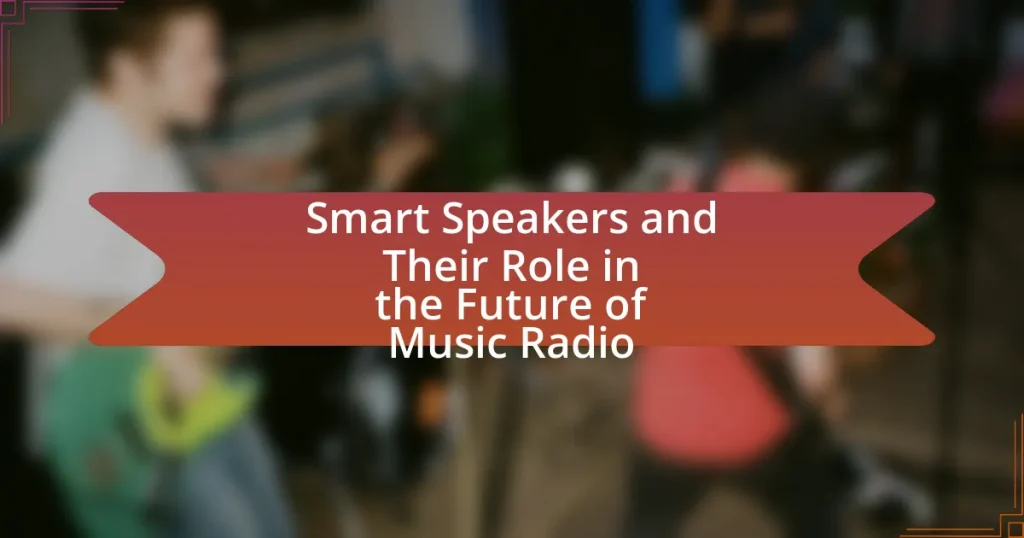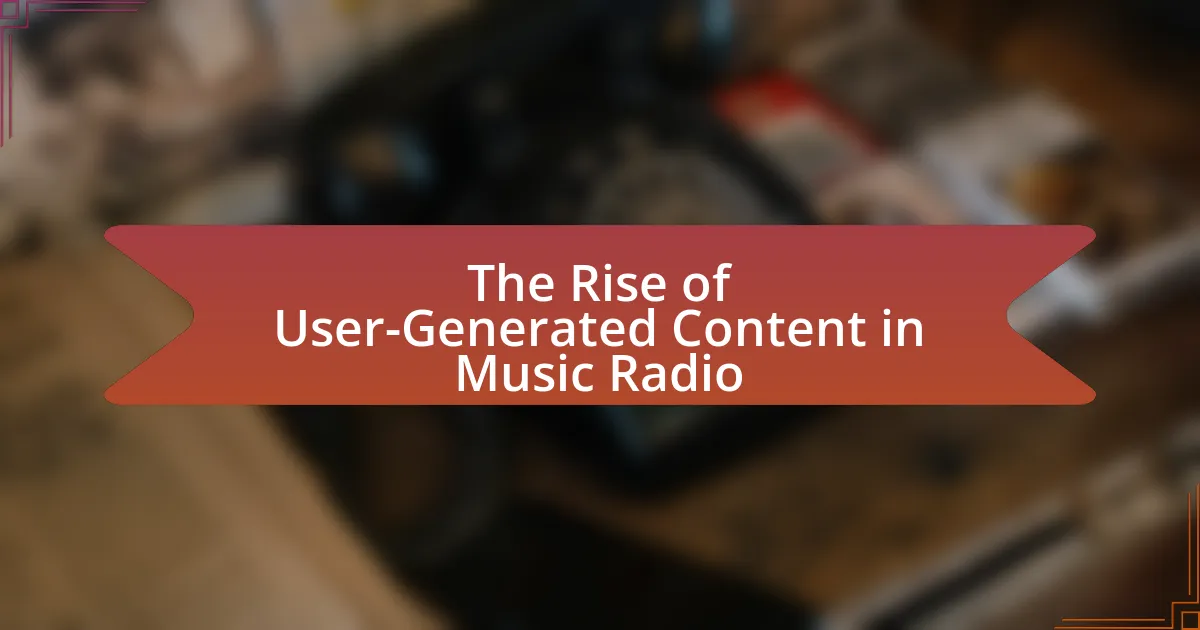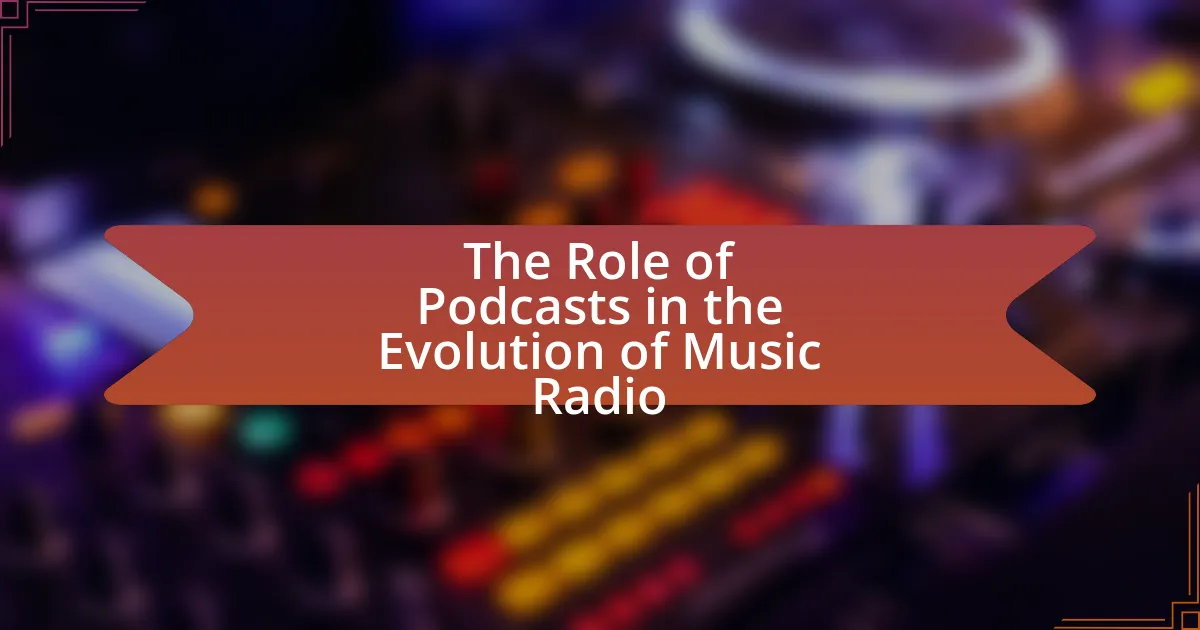Smart speakers are internet-connected devices that utilize voice recognition technology to stream music and radio, significantly impacting the music radio landscape. Their hands-free access to a wide range of radio stations and music services enhances user convenience and engagement, with over 50% of U.S. households owning a smart speaker by 2021. The article explores how smart speakers function in music radio, the technologies that enable their capabilities, and the advantages they provide for listeners, including personalized experiences and improved accessibility. Additionally, it addresses the challenges faced by smart speakers in the music radio industry, privacy concerns, and the evolving preferences of users, ultimately highlighting the future role of smart speakers in transforming music radio consumption.

What are Smart Speakers and Their Significance in Music Radio?
Smart speakers are internet-connected devices that use voice recognition technology to perform tasks and provide information, including streaming music and radio. Their significance in music radio lies in their ability to offer hands-free access to a vast array of radio stations and music services, enhancing user convenience and engagement. According to a report by the Consumer Technology Association, over 50% of U.S. households owned a smart speaker by 2021, indicating a growing trend in audio consumption through these devices. This shift has transformed how listeners interact with radio, allowing for personalized experiences and on-demand content, which are crucial for the future of music radio.
How do Smart Speakers function in the context of music radio?
Smart speakers function as voice-activated devices that stream music radio by connecting to the internet and accessing various radio stations and music services. They utilize built-in virtual assistants, such as Amazon Alexa or Google Assistant, to interpret voice commands, allowing users to request specific stations, genres, or songs. For instance, a user can say, “Play NPR,” and the smart speaker will retrieve the live stream from the NPR radio station. This capability is supported by partnerships with streaming platforms like Spotify and TuneIn, which provide a vast library of radio content. Additionally, smart speakers often feature multi-room audio capabilities, enabling users to enjoy music radio throughout their homes seamlessly.
What technologies enable Smart Speakers to stream music?
Smart speakers utilize Wi-Fi connectivity, Bluetooth technology, and cloud-based services to stream music. Wi-Fi allows smart speakers to connect to the internet for accessing streaming services like Spotify and Apple Music, while Bluetooth enables direct pairing with smartphones or tablets for music playback. Cloud-based services store and manage vast music libraries, facilitating on-demand access to songs and playlists. These technologies collectively enhance the user experience by providing seamless and instant music streaming capabilities.
How do voice recognition and AI enhance user experience with Smart Speakers?
Voice recognition and AI significantly enhance user experience with smart speakers by enabling intuitive, hands-free interaction and personalized responses. These technologies allow users to control devices, access information, and manage tasks through natural language commands, making the experience seamless and efficient. For instance, a study by Voicebot.ai in 2021 found that 75% of smart speaker users prefer voice commands over traditional interfaces, highlighting the convenience offered by voice recognition. Additionally, AI algorithms analyze user preferences and behaviors, allowing smart speakers to provide tailored recommendations, such as music playlists or news updates, further enriching the user experience.
What advantages do Smart Speakers provide for music radio listeners?
Smart speakers offer music radio listeners enhanced convenience, personalized experiences, and seamless integration with various streaming services. These devices allow users to easily access their favorite radio stations and playlists through voice commands, eliminating the need for manual tuning or searching. Additionally, smart speakers can curate music recommendations based on listening habits, providing a tailored experience that traditional radios cannot match. According to a report by the Consumer Technology Association, 70% of smart speaker owners use their devices for music, highlighting their popularity and effectiveness in delivering music radio content.
How do Smart Speakers improve accessibility to music radio?
Smart speakers enhance accessibility to music radio by enabling voice-activated control, allowing users to easily request specific stations or genres without needing physical interaction. This hands-free operation is particularly beneficial for individuals with mobility impairments or visual disabilities, as they can access a wide range of radio content simply by speaking commands. According to a report by the Pew Research Center, 46% of Americans use voice assistants, indicating a growing reliance on this technology for everyday tasks, including listening to music radio.
What role do Smart Speakers play in personalizing music radio experiences?
Smart speakers play a crucial role in personalizing music radio experiences by utilizing voice recognition and machine learning algorithms to tailor content to individual user preferences. These devices analyze listening habits, favorite genres, and user interactions to create customized playlists and radio stations, enhancing user engagement. For instance, a study by NPR and Edison Research found that 70% of smart speaker users prefer personalized music recommendations, demonstrating the effectiveness of smart speakers in delivering tailored audio experiences.
How are Smart Speakers changing the landscape of music radio?
Smart speakers are transforming the landscape of music radio by enabling on-demand access to a vast array of audio content and personalized listening experiences. These devices facilitate streaming services and internet radio, allowing users to easily access their favorite stations or playlists through voice commands. According to a report by Edison Research, 70% of smart speaker owners listen to music daily, indicating a significant shift from traditional radio to digital platforms. This shift is further supported by the fact that smart speakers have become a primary device for audio consumption, with 50% of users preferring them over traditional radios for music listening.
What impact do Smart Speakers have on traditional radio broadcasting?
Smart speakers significantly disrupt traditional radio broadcasting by shifting listener habits towards on-demand audio content. The convenience of voice-activated technology allows users to access music, podcasts, and radio stations instantly, leading to a decline in traditional radio’s audience. According to a 2020 report by Edison Research, 41% of smart speaker owners listen to less traditional radio since acquiring their device, indicating a clear trend away from conventional broadcasting. This shift challenges radio stations to adapt their content strategies to remain relevant in an increasingly digital audio landscape.
How are music radio stations adapting to the rise of Smart Speakers?
Music radio stations are adapting to the rise of smart speakers by enhancing their digital presence and optimizing content for voice-activated platforms. This adaptation includes developing skills for platforms like Amazon Alexa and Google Assistant, allowing users to easily access live broadcasts and on-demand content through voice commands. According to a report by Edison Research, over 50% of smart speaker owners listen to radio through their devices, highlighting the importance of this adaptation for reaching audiences. Additionally, radio stations are leveraging data analytics from smart speakers to better understand listener preferences and tailor programming accordingly, ensuring they remain relevant in a rapidly evolving audio landscape.
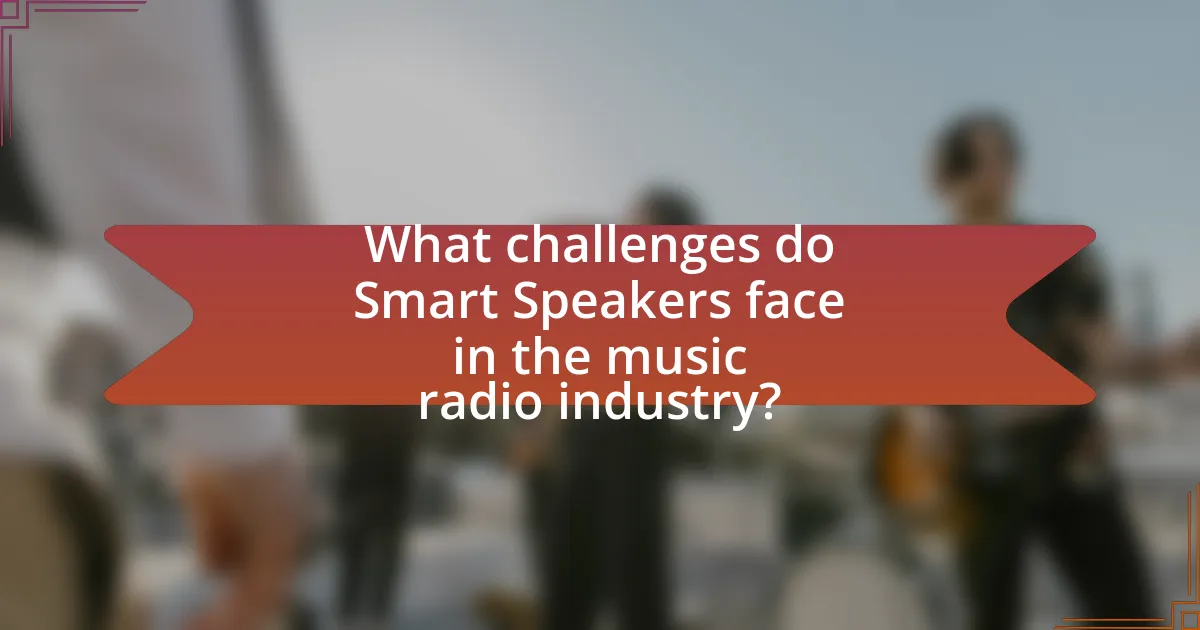
What challenges do Smart Speakers face in the music radio industry?
Smart speakers face significant challenges in the music radio industry, primarily due to competition from streaming services and the need for integration with various radio platforms. The rise of platforms like Spotify and Apple Music has shifted listener preferences towards on-demand content, which diminishes the traditional radio audience. Additionally, smart speakers often rely on third-party applications for radio access, which can lead to inconsistent user experiences and limitations in content availability. According to a 2022 report by Edison Research, 41% of smart speaker owners listen to music through streaming services rather than traditional radio, highlighting this shift in consumer behavior. Furthermore, issues related to voice recognition accuracy and the ability to navigate radio content effectively can hinder user engagement with radio stations via smart speakers.
What privacy concerns are associated with Smart Speakers?
Smart speakers raise significant privacy concerns primarily due to their always-on listening capabilities. These devices continuously monitor ambient sounds to detect wake words, which can lead to unintended recordings of private conversations. Research by the Electronic Frontier Foundation highlights that data collected by smart speakers can be stored indefinitely and may be accessed by third parties, including law enforcement, without user consent. Additionally, vulnerabilities in smart speaker software can expose users to hacking, allowing unauthorized access to personal information.
How do data collection practices affect user trust in Smart Speakers?
Data collection practices significantly impact user trust in Smart Speakers by influencing perceptions of privacy and security. When users are aware that their voice data and personal information are being collected, they may feel vulnerable to potential misuse, leading to decreased trust. A study by Pew Research Center found that 81% of Americans feel that the potential risks of data collection by companies outweigh the benefits, highlighting a general skepticism towards data practices. Furthermore, transparency in how data is used and shared can enhance trust; users are more likely to trust Smart Speakers that provide clear privacy policies and options for data control. Thus, effective data collection practices that prioritize user privacy can foster greater trust in Smart Speakers.
What measures can be taken to enhance privacy for Smart Speaker users?
To enhance privacy for Smart Speaker users, individuals can take several measures, including disabling voice activation features, regularly reviewing and deleting voice recordings, and adjusting privacy settings within the associated apps. Disabling voice activation prevents the device from listening continuously, thereby reducing the risk of unintended recordings. Regularly reviewing and deleting voice recordings can help users manage their data and limit exposure to potential breaches. Adjusting privacy settings allows users to control what data is shared with third-party services, thereby enhancing overall privacy. These actions are supported by privacy guidelines from organizations like the Electronic Frontier Foundation, which emphasize user control over personal data.
How do Smart Speakers compete with other music streaming services?
Smart speakers compete with other music streaming services by integrating voice-activated controls and offering seamless access to multiple platforms. This functionality allows users to easily request songs, playlists, or genres without needing to interact with a screen, enhancing user convenience. According to a report by Statista, as of 2023, over 50% of smart speaker users utilize their devices for music streaming, indicating a significant overlap in user engagement between smart speakers and traditional music streaming services. Additionally, smart speakers often come with exclusive features, such as personalized playlists and smart home integration, which further differentiate them from standalone music streaming applications.
What differentiates Smart Speakers from traditional music streaming platforms?
Smart speakers are distinct from traditional music streaming platforms primarily due to their integrated voice-activated technology, enabling hands-free control and interaction. While traditional music streaming platforms require manual input through devices like smartphones or computers, smart speakers allow users to play music, adjust volume, and access information using voice commands. This functionality is supported by advancements in natural language processing and artificial intelligence, which enhance user experience by providing personalized recommendations and seamless integration with smart home devices. For instance, according to a report by Statista, the global smart speaker market is projected to reach 35 million units sold by 2025, highlighting the growing preference for voice-activated technology over conventional streaming methods.
How do Smart Speakers influence listener habits compared to other devices?
Smart speakers significantly influence listener habits by promoting hands-free interaction and personalized content delivery, which differs from traditional devices like radios and smartphones. Research indicates that users of smart speakers engage in more frequent listening sessions, with a study by NPR and Edison Research showing that 70% of smart speaker owners listen to music daily, compared to 50% of smartphone users. Additionally, smart speakers facilitate voice commands, allowing users to request specific songs or genres instantly, enhancing user engagement and satisfaction. This ease of access and personalization leads to longer listening durations and a broader exploration of music, setting smart speakers apart from other devices.
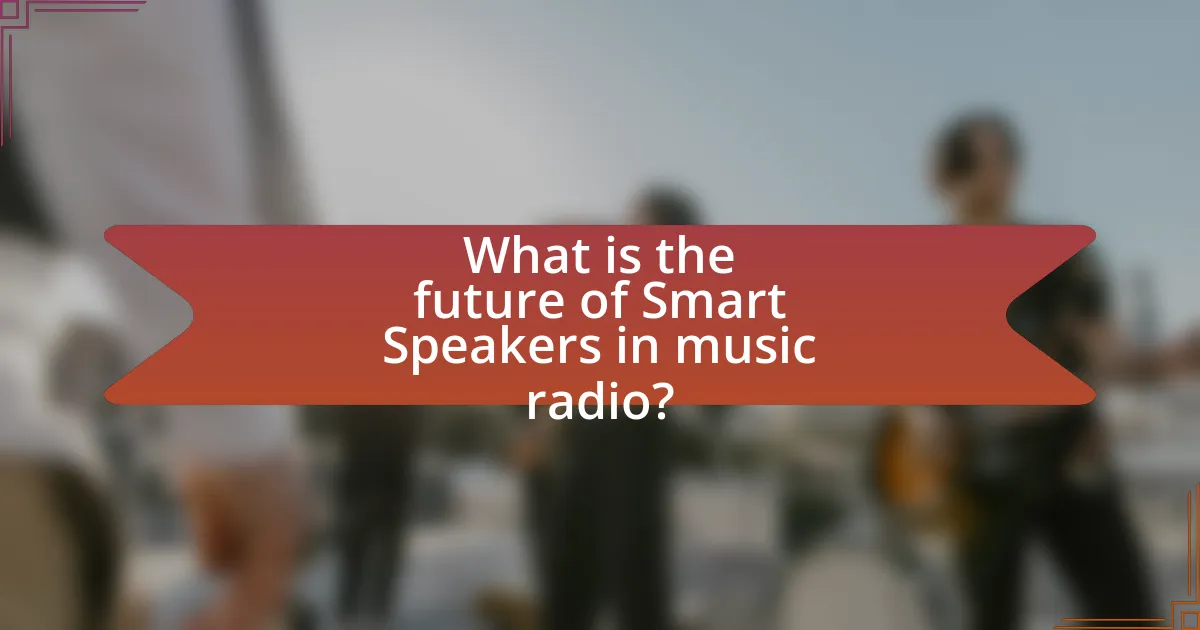
What is the future of Smart Speakers in music radio?
The future of smart speakers in music radio is poised for significant growth, driven by advancements in voice recognition technology and increased consumer adoption. Smart speakers are becoming central to how users access music and radio content, with a report from eMarketer indicating that over 50% of U.S. households are expected to own a smart speaker by 2024. This widespread adoption facilitates seamless integration of music streaming services and radio stations, allowing users to easily request specific songs or stations through voice commands. Additionally, smart speakers are enhancing user engagement through personalized recommendations and interactive features, which are likely to redefine the listening experience in music radio.
How will advancements in technology shape Smart Speakers’ role in music radio?
Advancements in technology will enhance Smart Speakers’ role in music radio by improving voice recognition, personalization, and integration with streaming services. Enhanced voice recognition allows users to interact more naturally with Smart Speakers, making it easier to request specific songs, genres, or radio stations. Personalization algorithms will analyze user preferences and listening habits, enabling Smart Speakers to curate tailored playlists and recommend new music, thereby increasing user engagement. Furthermore, seamless integration with various streaming platforms will allow Smart Speakers to access a broader range of content, including live radio broadcasts and on-demand music, thus transforming how users experience music radio. These developments are supported by the growing adoption of AI and machine learning technologies, which are projected to drive significant improvements in user interaction and content delivery in the coming years.
What emerging technologies could enhance Smart Speaker capabilities?
Emerging technologies that could enhance Smart Speaker capabilities include advanced natural language processing (NLP), machine learning algorithms, and voice recognition improvements. Advanced NLP allows for more nuanced understanding of user commands, enabling smarter interactions. Machine learning algorithms can personalize user experiences by analyzing preferences and behaviors, leading to tailored content recommendations. Enhanced voice recognition technologies, such as multi-speaker identification and noise cancellation, improve accuracy in diverse environments, ensuring that commands are understood correctly. These advancements collectively contribute to a more intuitive and user-friendly experience, aligning with the growing demand for seamless integration in smart home ecosystems.
How might user preferences evolve in relation to Smart Speakers and music radio?
User preferences regarding Smart Speakers and music radio are likely to evolve towards increased personalization and integration with streaming services. As Smart Speakers become more sophisticated, users will expect tailored music recommendations based on their listening habits, which is supported by data showing that 70% of users prefer personalized content. Additionally, the convenience of voice commands will drive users to favor Smart Speakers over traditional radio, as evidenced by a 2022 survey indicating that 60% of respondents use voice-activated devices for music playback. This shift will lead to a decline in traditional radio listenership as users prioritize on-demand access to music and curated playlists.
What best practices should users follow when using Smart Speakers for music radio?
Users should ensure optimal sound quality and functionality when using smart speakers for music radio by following several best practices. First, users should position their smart speakers in a central location away from walls to enhance sound dispersion. This placement improves audio clarity and volume, as sound waves can travel freely. Second, users should regularly update their smart speaker software to access the latest features and improvements, which can enhance performance and compatibility with various music streaming services. Third, users should utilize voice commands effectively by speaking clearly and using specific phrases to ensure accurate responses from the device. This practice minimizes misunderstandings and enhances the overall user experience. Lastly, users should explore and customize equalizer settings within the smart speaker app to tailor sound profiles to their preferences, ensuring a more enjoyable listening experience. These practices collectively contribute to a better interaction with smart speakers for music radio.
How can users optimize their Smart Speaker settings for a better music radio experience?
Users can optimize their Smart Speaker settings for a better music radio experience by adjusting audio quality settings, personalizing playlists, and utilizing voice commands effectively. Adjusting audio quality settings can enhance sound clarity; many Smart Speakers allow users to select high-definition audio options. Personalizing playlists ensures that the music selection aligns with user preferences, which can be done through the speaker’s companion app or voice commands. Utilizing voice commands effectively allows users to quickly access specific stations or genres, improving the overall listening experience. These adjustments lead to a more tailored and enjoyable music radio experience, as evidenced by user satisfaction surveys indicating that personalized content significantly enhances engagement with audio platforms.
What tips can enhance the integration of Smart Speakers with home audio systems?
To enhance the integration of Smart Speakers with home audio systems, ensure compatibility by selecting smart speakers that support multi-room audio and have the necessary connectivity options, such as Bluetooth or Wi-Fi. This compatibility allows seamless streaming across devices. Additionally, utilize a centralized app or platform that can control both the smart speaker and the home audio system, simplifying user experience and functionality. For optimal sound quality, position the smart speaker strategically within the room to avoid obstructions and ensure it is connected to a high-quality audio receiver. Research indicates that proper placement can significantly improve audio performance, as sound waves interact with the environment.
